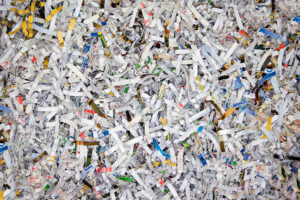In the fast-paced world of healthcare, the management of sensitive documents is a paramount concern. Patient confidentiality and compliance with privacy regulations are non-negotiable aspects of healthcare operations. In this blog, we delve into the crucial matter of destroying healthcare documents properly, exploring not only the methods for secure destruction but also the compelling reasons why this process is of utmost importance.
I. Patient Confidentiality: A Fundamental Principle:
At the core of healthcare operations lies the principle of patient confidentiality. Protecting the privacy of patient information is not only a legal obligation but an ethical imperative. Healthcare documents contain a wealth of sensitive information, including medical histories, treatment plans, and personal details that must be handled with the utmost care.
II. Legal Compliance:
Healthcare providers are subject to a myriad of regulations and laws governing the protection of patient information. The Health Insurance Portability and Accountability Act (HIPAA) in the United States, for example, mandates strict standards for the privacy and security of health information. Properly destroying healthcare documents is a key component of compliance with these regulations.
III. Methods for Secure Document Destruction:
a. Shredding: Shredding is a widely recognized and efficient method for destroying healthcare documents. Cross-cut or micro-cut shredders are particularly effective, rendering documents into confetti-like pieces that are nearly impossible to reconstruct.
b. Incineration: Incineration is another secure method for document destruction. Specialized services can incinerate documents at high temperatures, ensuring complete destruction of sensitive information.
c. Pulping: In some cases, documents can be pulped, breaking down the paper fibers into a slurry. This method is particularly effective for rendering documents unreadable and is often used for large-scale destruction.
d. Degaussing (for Electronic Media): For electronic healthcare documents stored on magnetic media, degaussing involves erasing the magnetic field, rendering the information irretrievable. This method is crucial for protecting electronic patient records.
IV. Preventing Identity Theft and Fraud:
Properly destroying healthcare documents is a powerful deterrent against identity theft and fraud. Patient information, if it falls into the wrong hands, can be exploited for financial gain, making secure document destruction a critical step in safeguarding individuals from these risks.
V. Preserving Trust and Reputation:
Trust is the bedrock of the healthcare provider-patient relationship. A breach in patient confidentiality due to mishandling of healthcare documents can erode this trust, damaging the reputation of the healthcare organization. Secure document destruction is a proactive measure to maintain the trust and confidence of patients.
VI. Environmental Considerations:
Choosing eco-friendly methods for document destruction, such as recycling shredded paper, aligns with broader sustainability goals. Healthcare providers can contribute to environmental responsibility by incorporating green practices into their document disposal procedures.
VII. Ongoing Education and Training:
To ensure the proper destruction of healthcare documents, ongoing education and training for healthcare staff are essential. Staff should be well-versed in the importance of secure document disposal and the specific procedures to follow within their healthcare organization.
Conclusion:
In the healthcare landscape, where the protection of patient information is paramount, the proper destruction of healthcare documents is not just a routine task; it’s a critical responsibility. By implementing secure methods like shredding, incineration, and degaussing, healthcare providers can fortify patient confidentiality, comply with regulations, and safeguard against identity theft and fraud. As custodians of sensitive information, healthcare organizations play a pivotal role in preserving trust, upholding reputation, and contributing to a culture of ethical and responsible document management. In an age where information is a powerful asset, the proper destruction of healthcare documents is a vital step towards securing the integrity of the healthcare system and the well-being of patients.










